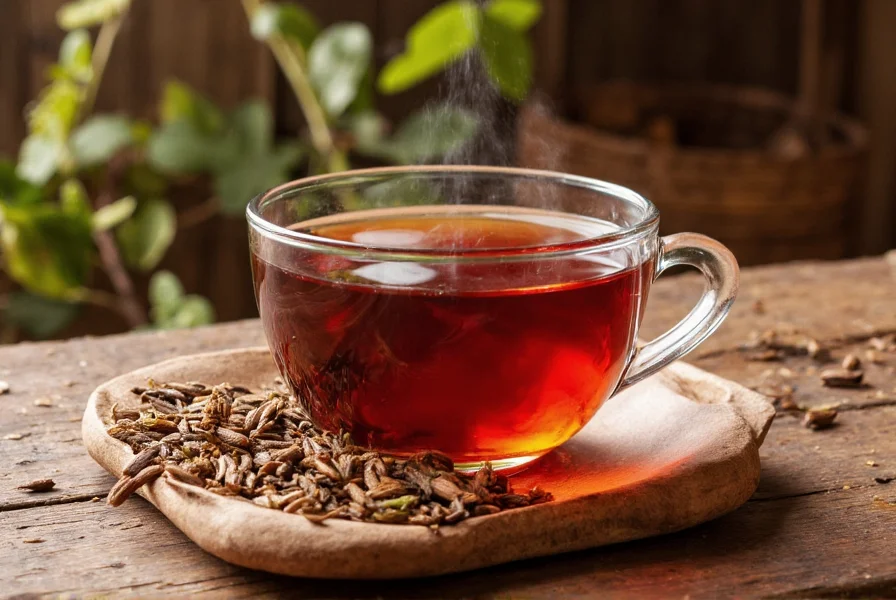Cumin tea has been used for centuries across Middle Eastern, Indian, and Mediterranean cultures as both a culinary ingredient and traditional remedy. This aromatic herbal infusion offers more than just distinctive flavor—it delivers bioactive compounds with potential health implications supported by emerging scientific research.
What Is Cumin Tea?
Cumin tea isn't technically a "tea" in the botanical sense, as it doesn't come from the Camellia sinensis plant. Instead, it's an herbal infusion (tisane) created by steeping cumin seeds—either whole or ground—in hot water. The resulting beverage carries cumin's characteristic warm, earthy flavor with subtle citrus notes.

Nutritional Profile of Cumin Tea
While cumin tea contains minimal calories, it delivers concentrated bioactive compounds from the seeds. A typical cup provides:
| Nutrient/Compound | Amount per Cup | Significance |
|---|---|---|
| Thymoquinone | Trace amounts | Potential anti-inflammatory properties |
| Antioxidants | Moderate levels | Combats oxidative stress |
| Iron | Small amount | Supports oxygen transport |
| Vitamin B complex | Trace amounts | Energy metabolism support |
Evidence-Based Health Benefits of Cumin Tea
Research on cumin tea specifically remains limited, but studies on cumin seeds provide insight into potential benefits when consumed as an infusion:
Digestive Health Support
Cumin tea benefits for digestion represent its most well-documented application. A 2019 review in Phytotherapy Research noted cumin's traditional use for digestive complaints. The tea may stimulate digestive enzymes, potentially reducing bloating and improving nutrient absorption—making it an excellent after-dinner herbal tea option.
Blood Sugar Regulation
Preliminary research suggests cumin compounds might support healthy blood glucose levels. A 2014 study in Nutrition Research found that cumin supplementation improved insulin resistance in participants with type 2 diabetes. While more research specifically on the tea form is needed, these findings indicate potential benefits for metabolic health.
Anti-Inflammatory Properties
The thymoquinone and other compounds in cumin demonstrate anti-inflammatory effects in laboratory studies. Regular consumption of cumin tea for inflammation management shows promise, though human clinical trials specifically examining the tea are limited.
How to Prepare Authentic Cumin Tea
Creating effective cumin tea requires proper technique to extract maximum benefits:
- Toast the seeds: Lightly toast 1 teaspoon of whole cumin seeds in a dry pan until fragrant (about 1-2 minutes)
- Crush gently: Use a mortar and pestle to slightly crack the seeds (don't grind to powder)
- Steep properly: Pour 8 ounces of just-boiled water over seeds and steep covered for 8-10 minutes
- Strain and enhance: Remove seeds and add lemon juice or a small amount of honey if desired

Optimal Timing for Cumin Tea Consumption
When to drink cumin tea depends on your health goals:
- For digestion: Consume 15-20 minutes before meals or immediately after eating
- For blood sugar management: Drink before carbohydrate-rich meals
- For general wellness: Morning or evening, but avoid late evening consumption as it may be slightly stimulating
Potential Side Effects and Precautions
Cumin tea is generally safe for most people when consumed in moderate amounts (1-2 cups daily). However, certain individuals should exercise caution:
- Pregnant women should limit consumption as high amounts may stimulate uterine contractions
- Those with bleeding disorders should consult a healthcare provider due to potential anticoagulant effects
- Individuals with gallstones should avoid excessive consumption as cumin may increase bile production
- People taking diabetes medications should monitor blood sugar closely as cumin may enhance medication effects
Cumin Tea Versus Other Herbal Teas
How does cumin tea compare to more common herbal infusions?
- Compared to ginger tea: Both support digestion, but cumin offers more iron while ginger provides stronger anti-nausea effects
- Compared to peppermint tea: Peppermint offers more immediate relief for IBS symptoms, while cumin provides longer-term digestive support
- Compared to chamomile: Chamomile promotes relaxation and sleep, while cumin offers more metabolic benefits
Scientific Research Status
While traditional use of cumin tea spans centuries, modern scientific validation remains in early stages. Most research examines cumin seeds or extracts rather than the tea preparation specifically. A 2020 review in Comprehensive Reviews in Food Science and Food Safety noted promising preliminary findings but called for more human clinical trials focused specifically on cumin tea consumption patterns.
Creating Flavorful Cumin Tea Variations
Enhance your cumin tea experience with these evidence-based combinations:
- Cumin-lemon-ginger tea: Combines digestive benefits of all three ingredients
- Cumin-cardamom tea: Traditional Middle Eastern combination that may enhance metabolic benefits
- Cumin-fennel tea: Excellent for reducing bloating and gas











 浙公网安备
33010002000092号
浙公网安备
33010002000092号 浙B2-20120091-4
浙B2-20120091-4